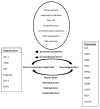Growth Factors in the Pathogenesis of Retinal Neurodegeneration in Diabetes Mellitus
- PMID: 27528260
- PMCID: PMC5333593
- DOI: 10.2174/1570159x14666160813182009
Growth Factors in the Pathogenesis of Retinal Neurodegeneration in Diabetes Mellitus
Abstract
Neurodegeneration is an initial process in the development of diabetic retinopathy (DR). High quantities of glutamate, oxidative stress, induction of the renin-angiotensin system (RAS) and elevated levels of RAGE are crucial elements in the retinal neurodegeneration caused by diabetes mellitus. At least, there is emerging proof to indicate that the equilibrium between the neurotoxic and neuroprotective components will affect the state of the retinal neurons. Somatostatin (SST), pigment epithelium-derived factor (PEDF), and erythropoietin (Epo) are endogenous neuroprotective peptides that are decreased in the eye of diabetic persons and play an essential role in retinal homeostasis. On the other hand, insulin-like growth factor 1 (IGF-1), and vascular endothelial growth factor (VEGF) are pivotal proteins which participate in the development of new capillaries and finally cause damage to the retinal neurons. During recent years, our knowledge about the function of growth factors in the pathogenesis of retinal neurodegeneration has increased. However, intensive investigations are needed to clarify the basic processes that contribute to retinal neurodegeneration and its association with damage to the capillary blood vessels. The objective of this review article is to show new insights on the role of neurotransmitters and growth factors in the pathogenesis of diabetic retinopathy. The information contained in this manuscript may provide the basis for novel strategies based on the factors of neurodegeneration to diagnose, prevent and treat DR in its earliest phases.
Figures
Similar articles
-
Alteration of growth factors and neuronal death in diabetic retinopathy: what we have learned so far.Mol Vis. 2011 Jan 28;17:300-8. Mol Vis. 2011. PMID: 21293735 Free PMC article. Review.
-
Somatostatin replacement: a new strategy for treating diabetic retinopathy.Curr Med Chem. 2013;20(26):3251-7. doi: 10.2174/09298673113209990024. Curr Med Chem. 2013. PMID: 23745546 Review.
-
Cellular and Molecular Mechanisms of Neuronal Degeneration in Early-Stage Diabetic Retinopathy.Curr Vasc Pharmacol. 2024;22(5):301-315. doi: 10.2174/0115701611272737240426050930. Curr Vasc Pharmacol. 2024. PMID: 38693745 Review.
-
Neuroprotection in diabetic retinopathy.Curr Diab Rep. 2012 Aug;12(4):329-37. doi: 10.1007/s11892-012-0284-5. Curr Diab Rep. 2012. PMID: 22581259 Review.
-
Neurodegeneration: An early event of diabetic retinopathy.World J Diabetes. 2010 May 15;1(2):57-64. doi: 10.4239/wjd.v1.i2.57. World J Diabetes. 2010. PMID: 21537428 Free PMC article.
Cited by
-
Spermine oxidase: A promising therapeutic target for neurodegeneration in diabetic retinopathy.Pharmacol Res. 2019 Sep;147:104299. doi: 10.1016/j.phrs.2019.104299. Epub 2019 Jun 15. Pharmacol Res. 2019. PMID: 31207342 Free PMC article. Review.
-
Nanoparticle-Mediated Delivery of Neuroprotective Substances for the Treatment of Diabetic Retinopathy.Curr Neuropharmacol. 2018;16(7):993-1003. doi: 10.2174/1570159X15666170717115654. Curr Neuropharmacol. 2018. PMID: 28714394 Free PMC article. Review.
-
Targeting neurotrophic dysregulation in diabetic retinopathy: a novel therapeutic avenue.Mol Biol Rep. 2025 Jun 9;52(1):570. doi: 10.1007/s11033-025-10671-4. Mol Biol Rep. 2025. PMID: 40488922 Review.
-
Protective effects on the retina after ranibizumab treatment in an ischemia model.PLoS One. 2017 Aug 11;12(8):e0182407. doi: 10.1371/journal.pone.0182407. eCollection 2017. PLoS One. 2017. PMID: 28800629 Free PMC article.
-
EDITORIAL (Thematic Issue: Retinal Neurodegeneration in the Course of Diabetes: Neuroprotection as a Potential Treatment Target).Curr Neuropharmacol. 2016;14(8):782-783. doi: 10.2174/1570159x1408161031122537. Curr Neuropharmacol. 2016. PMID: 28029076 Free PMC article. No abstract available.
References
-
- Antonetti D.A., Barber A.J., Hollinger L.A., Wolpert E.B., Gardner T.W. Vascular endothelial growth factor induces rapid phosphorylation of tight junction proteins occludin and zonula occluden 1. A potential mechanism for vascular permeability in diabetic retinopathy and tumors. J. Biol. Chem. 1999;274(33):23463–23467. [http://dx.doi.org/10.1074/jbc.274.33.23463]. [PMID: 10438525]. - PubMed
-
- Lopes-Virella M.F., Virella G. The role of immune and inflammatory processes in the development of macrovascular disease in diabetes. Front. Biosci. 2003;8:s750–s768. [http://dx. doi.org/10.2741/1141]. [PMID: 12957881]. - PubMed
-
- Takagi H. Molecular mechanisms of retinal neovascularization in diabetic retinopathy. Intern. Med. 2003;42(3):299–301. [http://dx. doi.org/10.2169/internalmedicine.42.299]. [PMID: 12705804]. - PubMed
-
- Antonetti D.A., Barber A.J., Bronson S.K., Freeman W.M., Gardner T.W., Jefferson L.S., Kester M., Kimball S.R., Krady J.K., LaNoue K.F., Norbury C.C., Quinn P.G., Sandirasegarane L., Simpson I.A. Diabetic retinopathy: seeing beyond glucose-induced microvascular disease. Diabetes. 2006;55(9):2401–2411. [http://dx.doi.org/10.2337/db05-1635]. [PMID: 16936187]. - PubMed
-
- Barber A.J., Gardner T.W., Abcouwer S.F. The significance of vascular and neural apoptosis to the pathology of diabetic retinopathy. Invest. Ophthalmol. Vis. Sci. 2011;52(2):1156–1163. [http://dx.doi.org/10.1167/iovs.10-6293]. [PMID: 21357409]. - PMC - PubMed
Publication types
MeSH terms
Substances
LinkOut - more resources
Full Text Sources
Other Literature Sources
Medical
Research Materials
Miscellaneous

